|
|
Olinda - Points of Interest
« Map of Historic Center of Olinda
« More information about Olinda
«Recife
«Pernambuco
Mercado Eufrásio Barbosa - Market Eufrásio Barbosa
 Located in the Varadouro, one of the entrances to the Historic Center.
Located in the Varadouro, one of the entrances to the Historic Center.
The building was a factory of cookies and sweets, opened in 1865; in 1979, the area was purchased by the City of Olinda, which installed the Market and a Theater, Teatro Fernando Santa Cruz.
The Market is occupied by small artisans who can't afford to have their own shops. Each artisan occupies a small kioske. With tens of kioskes, this is the largest place to buy handicraft in Olinda. These folks have subsidies and their prices are supposed to be lower; however, the name of the game is, as always, bargain.
Also, in front of the Market, there is a high concentration of "certified guides" who are trained by the City of Olinda to conduct visitors around the city. More than inside the market, bargain prices with these guides; they are supposed to accept "any donation or contribution", but some try to get donations of R$ 30. A more fair price is something between R$ 5 and R$ 10, paid after the tour.
Back to top
Ruínas do Senado - Wreckage of Senate
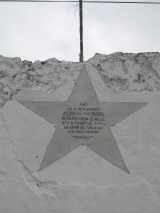 How the History of Brazil indeed happened: Brazil was a colony until 1822; in 1822, the son of the Portuguese King, Pedro I, declared Independence, and Brazil was an Empire (only Pedro I and his son Pedro II were Emperors) until 1889; in 1889, Brazil became a Republic.
How the History of Brazil indeed happened: Brazil was a colony until 1822; in 1822, the son of the Portuguese King, Pedro I, declared Independence, and Brazil was an Empire (only Pedro I and his son Pedro II were Emperors) until 1889; in 1889, Brazil became a Republic.
How History might have been: in 1710, Bernardo Vieira de Mello and his group attempted to proclaim a true Independence, and declare Brazil a Republic. The reading in the wall says: "Here, on November 10th of 1710, Bernardo Vieira de Mello shout loudly in favor of the formation of a Republic among us".
 Early in the 1700s, after the Dutch were expelled from Pernambuco, the farm lords of Olinda were facing the decadence of the sugar cane plantations (see History of Olinda); at the same time, Recife and their traders were becoming richer and influential. Olinda referred to the trade men of Recife as "mascates" (a pejorative term).
Early in the 1700s, after the Dutch were expelled from Pernambuco, the farm lords of Olinda were facing the decadence of the sugar cane plantations (see History of Olinda); at the same time, Recife and their traders were becoming richer and influential. Olinda referred to the trade men of Recife as "mascates" (a pejorative term).
Between 1710 and 1712, Olinda and Recife were in war against each other, which became known as "Guerra dos Mascates". Bernardo Vieira was appointed Governor of Pernambuco and was supposed to combat Olinda, but he sided with olindenses and fought the mascates.
Olinda was eventually defeated, Bernardo Vieira was arrested and sent to Portugal, were he died in prison. Today, Bernardo Vieira is name of the main street in Jaboatão dos Guararapes.
Olinda considers Bernardo Vieira a hero. The thick wall which would be the future Senate is preserved until today. Also, the stretch of street in front of the wall is preserved.
Back to top
Mercado da Ribeira - Market of Ribeira
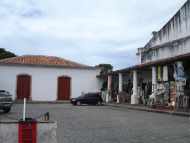 For centuries, slaves were traded here. Slavery was introduced in Brazil in the 1500s, and was abolished only in 1888.
For centuries, slaves were traded here. Slavery was introduced in Brazil in the 1500s, and was abolished only in 1888.
The white house is called "senzala", the place where slaves were kept. The slaves were brought outside and exposed in the middle yard. The lateral rooms were used for negotiations.
The name Ribeira means Creek, small river; there was probably a creek back then, but it's dry out today.
Today, the Market of Ribeira sells only handicrafts; each room is occupied by a different handicraft shop.
Back to top
Museu de Arte Sacra - Museum of Sacred Art
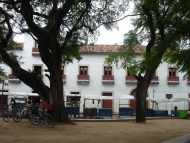 Located in the Alto da Sé. Located in the Alto da Sé.
The building was built in 1676, and served as Senate of Olinda and Palace of the Bishops; since 1974, the building has hosted the Museum of Sacred Art of Pernambuco (MASP).
The Museum exhibits ancient and modern art. Most of the ancient pieces were donated by the Archidioceses of Olinda and Recife, including pieces dating back to the 16th century.
Among the recent work, there is a set of eighteen passages of Passion of Christ, each one composed by a different artist from Pernambuco. Also, there is an exhibition of puppies who represent local characters, like Lampião and Zumbi dos Palmares.
Back to top
Museu de Arte Contemporânea - Museum of Contemporaneous Art
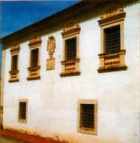 The building dates back to the 18th century, and was designed to serve as religious prison; for decades, those accused of conspiration against the Catholic Church were maintained captive here, under eclesiastic jurisdiction.
The building dates back to the 18th century, and was designed to serve as religious prison; for decades, those accused of conspiration against the Catholic Church were maintained captive here, under eclesiastic jurisdiction.
The building was designed in 1722 by Portuguese architects following official specifications, not the Church. This explains why the building looks like a real prison, not a religious one: the windows have grids and a frame in stone; there is no door in the first floor (which was reserved to blacks, crioles and witches); the external access ladder leads straight to the second floor, where white people were kept.
In 1966, the building was declared Brazilian National Heritage.
The Museum exhibits permanently works by famous Brazilian artists, like Cândido Portinari, Hilton das Gravuras, Vicente Monteiro and others. Besides, the Museum promotes temporary exhibitions focused on local culture and folklore.
Back to top
Casa dos Bonecos Gigantes - House of the Giant Puppies
The Giant Puppies have been, for the past 70 years, a constant presence in the carnival of Olinda. The first and most famous of such puppets, the Homem da Meia-Noite (Man of Midnight), goes out at midnight of Friday before carnival to officially announce the start of the party.
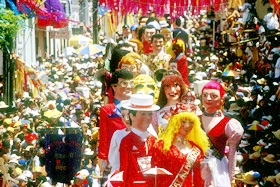 One of the climaxes of the carnival in Olinda is the Meeting of Giant Puppies, which happens the last day of carnival. Puppies leave from several corners of the city, and, escorted by frevo bands, walk all around the crowded streets before meeting in certain points. These puppets exercize an unexplicable fascination on the crowd, and certainly help cheer up the party.
One of the climaxes of the carnival in Olinda is the Meeting of Giant Puppies, which happens the last day of carnival. Puppies leave from several corners of the city, and, escorted by frevo bands, walk all around the crowded streets before meeting in certain points. These puppets exercize an unexplicable fascination on the crowd, and certainly help cheer up the party.
The main responsible for the family of puppets is plastic artist Sílvio Botelho. Born in Olinda, Botelho started working in carnival at age of 9, making masks. In 1974, when the only puppets were the Man of Midnight and the Woman of Midday, Botelho was hired to build the Menino da Tarde (Boy of Afternoon); the work was so impressive that, from that year, Botelho didn't stop producing more and more puppets every year.
Today, Botelho, the "father of puppets", is responsible for producing more than 90% of the puppets of Olinda. Each puppet stands in average 3.6 meters and weights 50 kg. Most puppets are produced by commend of blocks or companies; it takes at least one week to complete each puppet, at a cost of approximately R$ 2.8 thousand (values of 2005, about US$ 1,000).
Mr. Botelho's shop is located at Rua do Amparo, and is open to the public, from Monday through Friday.
Back to top
Museu Regional - Regional Museum
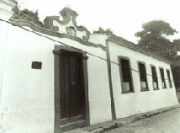 Whereas other important museums of Olinda were established in Historic buildings, this Regional Museum was established in a colonial house. Visiting the Museum permits not only to get in touch with the regional culture, but also to see how a house in Pernambuco in the 18th century was like.
Whereas other important museums of Olinda were established in Historic buildings, this Regional Museum was established in a colonial house. Visiting the Museum permits not only to get in touch with the regional culture, but also to see how a house in Pernambuco in the 18th century was like.
The house was built sometime between 1745 and 1749, to be home of the Bishop of Olinda; the symbols in the façade, above the main gate, indicate the presence of eclesiastic authorities; notice, also, that the ceiling had three layers of tiles, a sign of financial capability (read more in the comments about the Monastery of São Bento).
The house has three spacious saloons, and only one bedroom. The furniture includes pieces of colonial Brazil, sacred art from centuries 16 and 17, Chinese and French porcelain, Portuguese tiles and other goods which show the grandness of an episcopal house in times past.
The Museum is located at rua do Amparo, one of the oldest and most traditional neighbourhoods in Historic Olinda.
Back to top
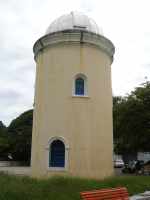
Observatório - Observatorium
Until 1860, the Royal Observatorium was managed by French astronomer Emmanuel Liais, and was mobile. Mr. Liais was researching the Brazilian coast and noticed that Olinda was a good spot for observations; he fixed the observatorium at the Alto da Sé and managed to discover a new comet, that he called Olinda; in 1882, the observatorium of Olinda was important for the study of the passage of Venus over the solar disk (see ilustration here).
From 1920 to 1960 the observatorium was used mostly for meteorologic studies; in the 1970s, it was deactivated, and the telescopes sent to the Torre Malakof, in Recife.
The stratetic position of the Observatorium, at the height of Alto da Sé, makes it an excellent place to appreciate the scenery of Olinda and Recife.
Back to top
Informações Turísticas - Tourist Information
 Make this your first stop when visiting Olinda. It is located near Praça do Carmo, in front of the Igreja do Carmo. If you are coming by bus from Recife (see more info on how to get to Olinda), just get off at the Post Office stop (Parada dos Correios) and cross the street.
Make this your first stop when visiting Olinda. It is located near Praça do Carmo, in front of the Igreja do Carmo. If you are coming by bus from Recife (see more info on how to get to Olinda), just get off at the Post Office stop (Parada dos Correios) and cross the street.
The office is located at the basement of the Olinda Public Library (open to visitations too), with a discrete sign (see photo).
Staff speaks some English. The material available ranges from a single black and white map (that's what I got) to a tri-lingual multicolor folder (only the tourist guides seem to have copies of those, and they don't give it away).
Some notes about the guides: as soon as you approach Olinda, either by car or on foot, several guides try to sell you their services. Very few speak languages other than Portuguese. The prices are bargained on the spot; a fair price is around R$ 5 per person, more tips, if applicable. Give preference to guides wearing a badge and "uniform" (a t-shirt with the logo of Olinda); these people are given training by the city, and are more accountable.
The main problem is that, once the price is set, the guide may not be interested in touring all the city (he may be rushed to finish your tour and be hired for another one). A complete tour should take between two and three hours. Make sure you have a map with the location of all the spots you want to see, and make sure that the guide took you there.
Back to top
Palácio dos Governadores - Palace of Governors
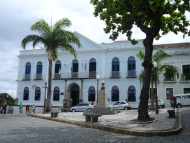 Palace of Governors. The building, from the 17th century, was home of the Governors of Olinda for a long time. Today, it is the seat of the Government of the Municipality of Olinda.
Palace of Governors. The building, from the 17th century, was home of the Governors of Olinda for a long time. Today, it is the seat of the Government of the Municipality of Olinda.
 Current mayor of Olinda is Luciana Santos, graduated in Electric Engineering; she is the only Mayor in Brazil affiliated to the Partido Comunista Brasileiro (Brazilian Communist Party).
Current mayor of Olinda is Luciana Santos, graduated in Electric Engineering; she is the only Mayor in Brazil affiliated to the Partido Comunista Brasileiro (Brazilian Communist Party).
Luciana was first elected Mayor for the term 2000 - 2004. In 2004, she ran for re-election, and won in the first round (meaning that the absolute majority of Olinda voted for her). Check out this biography (in Portuguese) of Luciana Santos, Mayor of Olinda.
Back to top
Arquivo Municipal - The Archives
Located next door to the Palácio dos Governadores. Created on March 2nd 1983. Open to the public.
Archives official documents, such as notary papers, laws and pictures.
It is the only Archive in the State of Pernambuco (Recife doesn't have an Archive - Historic documents are exposed, but not made available for consultations, at the Museu da Cidade); researchers interested in the History of Pernambuco may find this Archive useful.
Back to top
Câmara Municipal - Legislative House
The Legislators House of Olinda, the first to be installed in a city in Brazil. Open to the public. See site: http://www.camaramunicipaldeolinda.com.br/
Back to top
| |
 Located in the Varadouro, one of the entrances to the Historic Center.
Located in the Varadouro, one of the entrances to the Historic Center. How the History of Brazil indeed happened: Brazil was a colony until 1822; in 1822, the son of the Portuguese King, Pedro I, declared Independence, and Brazil was an Empire (only Pedro I and his son Pedro II were Emperors) until 1889; in 1889, Brazil became a Republic.
How the History of Brazil indeed happened: Brazil was a colony until 1822; in 1822, the son of the Portuguese King, Pedro I, declared Independence, and Brazil was an Empire (only Pedro I and his son Pedro II were Emperors) until 1889; in 1889, Brazil became a Republic. Early in the 1700s, after the Dutch were expelled from Pernambuco, the farm lords of Olinda were facing the decadence of the sugar cane plantations (see
Early in the 1700s, after the Dutch were expelled from Pernambuco, the farm lords of Olinda were facing the decadence of the sugar cane plantations (see  For centuries, slaves were traded here. Slavery was introduced in Brazil in the 1500s, and was abolished only in 1888.
For centuries, slaves were traded here. Slavery was introduced in Brazil in the 1500s, and was abolished only in 1888. Located in the Alto da Sé.
Located in the Alto da Sé. The building dates back to the 18th century, and was designed to serve as religious prison; for decades, those accused of conspiration against the Catholic Church were maintained captive here, under eclesiastic jurisdiction.
The building dates back to the 18th century, and was designed to serve as religious prison; for decades, those accused of conspiration against the Catholic Church were maintained captive here, under eclesiastic jurisdiction. One of the climaxes of the carnival in Olinda is the Meeting of Giant Puppies, which happens the last day of carnival. Puppies leave from several corners of the city, and, escorted by frevo bands, walk all around the crowded streets before meeting in certain points. These puppets exercize an unexplicable fascination on the crowd, and certainly help cheer up the party.
One of the climaxes of the carnival in Olinda is the Meeting of Giant Puppies, which happens the last day of carnival. Puppies leave from several corners of the city, and, escorted by frevo bands, walk all around the crowded streets before meeting in certain points. These puppets exercize an unexplicable fascination on the crowd, and certainly help cheer up the party. Whereas other important museums of Olinda were established in Historic buildings, this Regional Museum was established in a colonial house. Visiting the Museum permits not only to get in touch with the regional culture, but also to see how a house in Pernambuco in the 18th century was like.
Whereas other important museums of Olinda were established in Historic buildings, this Regional Museum was established in a colonial house. Visiting the Museum permits not only to get in touch with the regional culture, but also to see how a house in Pernambuco in the 18th century was like.
 Make this your first stop when visiting Olinda. It is located near Praça do Carmo, in front of the Igreja do Carmo. If you are coming by bus from Recife (see more info on
Make this your first stop when visiting Olinda. It is located near Praça do Carmo, in front of the Igreja do Carmo. If you are coming by bus from Recife (see more info on  Palace of Governors. The building, from the 17th century, was home of the Governors of Olinda for a long time. Today, it is the seat of the Government of the Municipality of Olinda.
Palace of Governors. The building, from the 17th century, was home of the Governors of Olinda for a long time. Today, it is the seat of the Government of the Municipality of Olinda. Current mayor of Olinda is Luciana Santos, graduated in Electric Engineering; she is the only Mayor in Brazil affiliated to the Partido Comunista Brasileiro (Brazilian Communist Party).
Current mayor of Olinda is Luciana Santos, graduated in Electric Engineering; she is the only Mayor in Brazil affiliated to the Partido Comunista Brasileiro (Brazilian Communist Party).